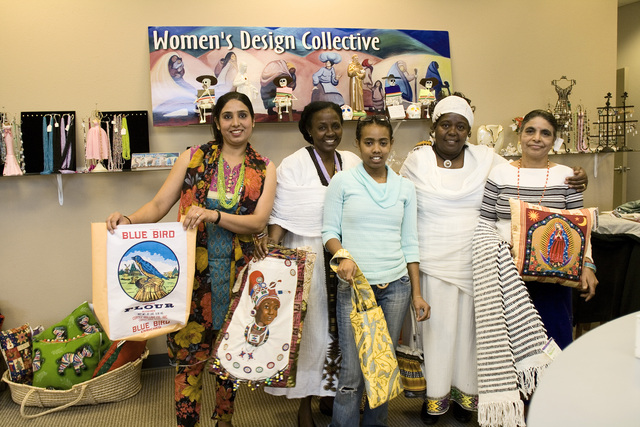About 30 women, 20 children and 10 languages were present at the last meeting of the Women’s Design Collective, tucked into a room scattered with fabric scraps and thread in the Southeast Heights. Some of the members helped translate the meeting’s minutes into Swahili, Amharic, Nepali, Kirundi, French, Kunama, Tigrinya, Somali, Spanish and, when needed, English. All of them worked on plans that would help launch their own businesses.Women’s Design Collective (WDC) is a program formed out of St. Joseph Community Health that teaches women basic craft skills. The hope, says Community Services Director Michelle Melendez, who’s responsible for getting the effort off the ground, is that women can use those skills in entrepreneurship to help feed their families.Most of the women who come to WDC are refugees or other kinds of immigrants—from places like Colombia, Mexico or Argentina—although there are a few members who are from the United States. Melendez says, with a little surprise in her voice, that all the women currently attending are married, but their husbands often have to take low-paying, demanding jobs because of their status in the country. If the women can begin to make a profit off their craft work, it could have a significant impact on their families’ quality of life.The program is run out of a storefront off San Pedro, south of Kathryn, in the area of town newly dubbed the International District. In the back of the space, a large workroom pulses with the sound of sewing machines and children playing. A childcare area adjoins the workroom, and someone is paid to watch the kids every day for four hours. In the main entrance, across from the welcome desk, a small showroom displays the bags, pillows, rugs, table runners and jewelry that make up the bulk of what WDC produces. “We’re not artists, we’re entrepreneurs,” says Melendez. Yet a look at the work WDC has produced argues otherwise. Materials are bright and eclectic. Eye-catching, multicolored “crazy bags” are emblazoned with images of Nelson Mandela. The artist, Nzaki Sinandile, came to Albuquerque from South Africa more than 20 years ago. Other totes, made from reused rice bags from Talin Market, are covered with patterned fabric and sold in the grocery store for between $15 and $30.Women’s Design Collective runs on a three-year grant of $750,000, given by St. Joseph’s parent organization, Catholic Health Initiatives. The program started in September 2008, and so it has about a year and a half before funds disappear. Melendez says she’s not sure what the program will do after that point, but she’s looking for ways to keep it operating. The program itself doesn’t make money. Artists (or entrepreneurs, as Melendez would call them) keep 100 percent of the money made off their products. The grant covers the rent of the space, equipment and limited materials. Women are given enough material to produce a small number of items, and if those items sell, they’re expected to reinvest the profit in more materials. Melendez says it’s a system that’s already working—some women have established clientele and are receiving orders. WDC also sets up booths at craft fairs throughout the city—five in the last half-year.There aren’t many requirements for women who want to join WDC—no income level is necessary. As long as people are willing to get involved with the program, help organize events and care for the space, they’re welcome, Melendez says. Those who are interested are encouraged to come near the beginning of the month to sign up for skill-building classes, as space is limited (WDC only has seven sewing machines, so class size is limited to seven participants). Classes meet once a week for four to six weeks. Once women complete training in basic sewing, they graduate to more advanced techniques in design. Women are then invited to come to the space to work and share what they’ve learned with each other.Most of the teaching, Melendez says, comes from the women themselves. Some of them end up hired to teach classes, but Melendez says even beyond that, they’re constantly renewing her inspiration for the program. “Whatever my idea was when we started, it has grown exponentially,” she says. “The women are so strong and so motivated. They have worked through so many harder issues than we have to work through here. There’s nothing really holding us back except the limits of our own imaginations.”
Women’s Design Collective 955 San Pedro SE, 268-1925Open Monday through Friday, 10 a.m. to 4 p.m.




